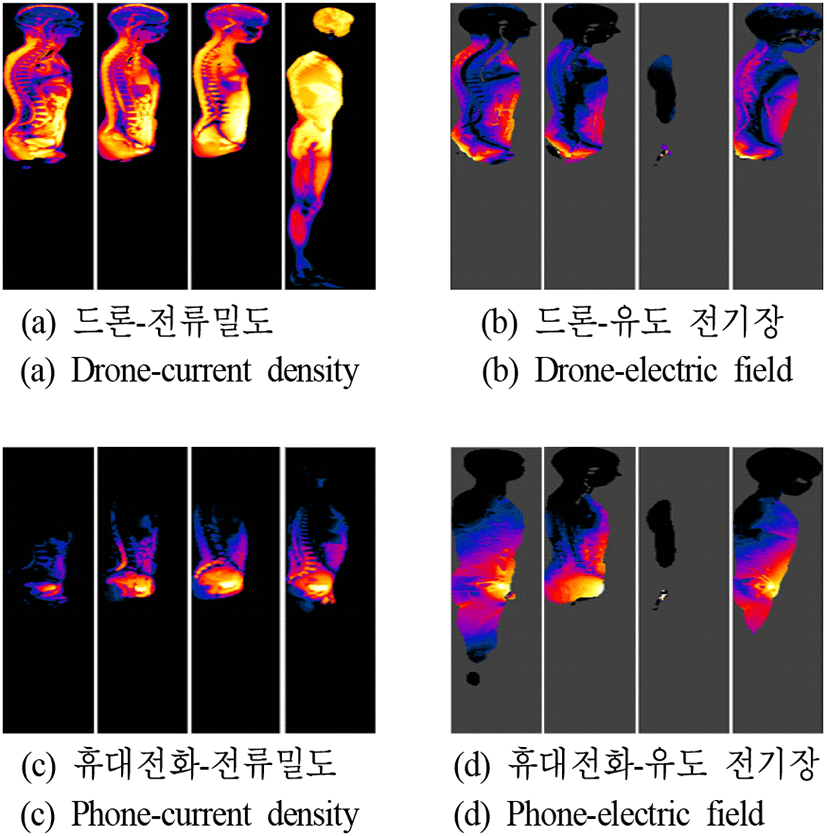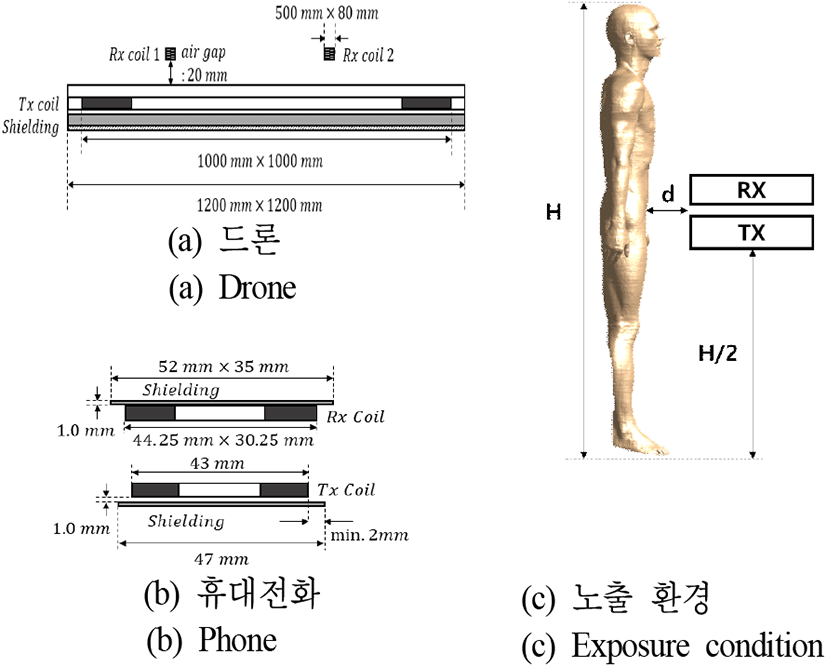특집논문/SPECIAL EDITION
저주파수 대역 무선전력전송 시스템에 의한 불균일 전자파 인체 노출량 분석
Numerical Analysis of Human Exposure to Nonuniform Electromagnetic Field from Low-Frequency Wireless Power Transfer Systems
Jangyong Ahn1
,
Sun-Eui Hong*
,
Hyung-Do Choi*
,
Seungyoung Ahn1,†
Author Information & Copyright ▼
*한국전자통신연구원 통신미디어연구소 전파위성연구본부
1The Cho Chun Shik Graduate School of Green Transportation, Korea Advanced Institute of Science and Technology
*Radio & Satellite Research Division, Electronics and Telecommunications Research Institute
© Copyright 2019 The Korean Institute of Electromagnetic Engineering and Science. This is an Open-Access article distributed under the terms of the
Creative Commons Attribution Non-Commercial License (http://creativecommons.org/licenses/by-nc/4.0/) which permits
unrestricted non-commercial use, distribution, and reproduction in any
medium, provided the original work is properly cited.
Received: Aug 12, 2020; Revised: Sep 10, 2020; Accepted: Oct 26, 2020
Published Online: Oct 31, 2020
요약
10 MHz 이하 저주파수 대역에서 무선전력전송 시스템의 전자파에 의한 인체 내부의 전류밀도 및 유도 전기장은 복셀 기반의 인체 모델을 사용하여 자기 준정적 근사 방법으로 계산된다. 복셀 기반의 인체 모델을 이용한 수치해석 과정에서 분할 및 이산화 등으로 발생할 수 있는 계산 불확도를 보완하기 위해 인체 노출량 평가에는 99th percentile을 적용한다. 본 논문에서는 사용 환경 및 시스템 특성이 서로 다른 두 무선전력전송 시스템에서 percentile에 따른 전류밀도 및 유도 전기장 특성을 분석하고, 각 percentile 적용에 따른 인체 노출량 평가 결과를 분석하였다.
Abstract
In a low-frequency band below 10 MHz, the induced current density and electric field in the human body exposed to an electromagnetic field from a wireless power transfer system are calculated using the magneto-quasi-static approximation method and a voxel-based human body model. The 99th percentile is applied to compensate for the computational uncertainty that may occur owing to segmentation and discretization during the numerical analysis process. In this study, the current density and induced electric field characteristics according to the percentile with two opposing wireless power transfer systems were analyzed. In addition, the human exposure based on each percentile application was evaluated.
Keywords: Wireless Power Transfer; Human Exposure; Low Frequency; Computational Artifact; Percentile
Ⅰ. 서 론
무선전력전송(WPT: wireless power transfer) 시스템은 휴대전화, 노트북과 같은 저전력 전자기기부터 드론, 전기차 등 고전력 시스템까지 다양한 기기들에서 활용되고 있다[1]. 그러나 WPT 시스템에서는 누설 자기장이 발생하며, 이는 시스템 주변의 인체에 악영향을 미칠 수 있다. 따라서, WPT 시스템에서 발생한 전자기장에 의한 인체 노출량 평가방법이 소개되었으며[2], 국제 가이드라인을 준수하도록 권고된다[3],[4].
전자기장과 인체와의 직접적인 상호 작용에 의한 영향은 신경 자극과 열적 영향으로 나눌 수 있으며, 신경 자극에 의한 영향은 전류밀도와 내부 전기장으로 평가하며, 열적 영향은 전자파 흡수율(SAR: specific absorption rate)로 평가한다. 신경 자극 효과는 100 kHz 이하의 낮은 주파수 대역에서 지배적이며, 열적 효과는 10 MHz 이상의 주파수 대역에서 지배적이다[3],[4]. WPT 시스템에서 발생하는 전자기장에 의한 인체 전자파 노출량 평가는 주로 10 MHz 이하의 대역을 다루고 있다[3]. 다만, 10 MHz 이하 대역에서는 인체 내부 물리량(전류밀도, 전기장, SAR)을 측정하기 어려워 수치해석 기법을 이용하여 연구되고 있다.
10 MHz 이하의 주파수 대역은 변위전류가 옴 전류 대비 무시할 수 있는 수준이며, 인체 내 유도된 전류에 의해 발생한 자기장이 입사된 자기장과 비교하여 무시 가능한 수준이므로 MQS(magneto-quasi-static) 해석 방법을 사용할 수 있다[5]. 이는 인체 모델이 위치할 공간상에서의 정자기 벡터 포텐셜을 계산하고, 이를 소스로 인체 모델에 유도된 내부 물리량을 계산한다. 하지만, 저주파수 대역 전자파 인체 선량(dosimtery) 평가에 사용되는 내부 물리량은 계산 결함(computational artifact)을 포함할 수 있다. 계산 결함은 해부학적 인체 모델이 실제 인체의 MRI(magnetic resonance imaging) 및 CT(computed tomography) 기반의 복셀 모델이기 때문에, 분할(segmentation) 오류 또는 모델링 및 해석에서의 이산화(discretization) 오류 등으로 인해 발생할 수 있다[6]. 이러한 계산 결함으로 인한 불확도를 극복하기 위해서 1 %의 피크(peak)를 제거한 99th percentile을 적용하는 방법이 제안되고 적용되었다[7],[8]. 하지만, WPT 시스템과 같은 국부 노출 환경에서는 99th percentile을 적용하는 것이 과소 평가를 야기할 수 있기 때문에 부적합할 수 있다[9].
본 논문에서는 사용 환경이 서로 다른 두 WPT 시스템을 모델링하고, 발생한 전자기장에 의한 인체 내부 물리량을 percentile에 따라 다양한 인체 모델에서 인체 노출량 평가 결과를 분석하였다.
Ⅱ. 무선전력전송 시스템 모델링
전자기장에 의한 전류밀도 및 유도 전기장을 계산하기 위해서 그림 1(a), 그림 1(b)와 같이 상대적으로 높은 전력을 사용하고 시스템 크기가 큰 드론 WPT 시스템과 낮은 전력을 사용하고, 크기가 작은 휴대전화 WPT 시스템을 설계하였다. 드론 WPT 시스템은 공진주파수 140 kHz, 최대 송신전력 약 200 W, 약 1.2 m×1.2 m의 크기로 설계되었으며, 자기장 세기 측정과의 비교를 통해 검증되었다[10]. 휴대전화 WPT 시스템은 Qi 표준에서 제공하는 TX A 10과 RX 예시 1 모델을 기준으로 설계하였으며, 이는 공진주파수 111 kHz, 약 50 mm×50 mm크기의 5 W 급으로 설계되었다[11].
Ⅲ. 수치해석 방법
WPT 시스템에서 발생한 전자기장에 의한 전류밀도 및 유도 전기장은 MQS 근사법을 적용하여 계산하였다. 인체 모델 내 조직에 유도된 전류밀도는 인체 모델이 균일한 도전율을 갖고, 유도 전류를 추정하기 위한 원형 전도 루프 모델이라고 가정할 때, 식 (1)과 같이 도전율 σ와 루프 반지름 R, 인가된 자속 밀도 B 비례한다[3]. 반면, 유도 전기장은 식 (2)와 같이 전기 스칼라 포텐셜 ϕ와 Biot-Savart 법칙을 이용해 계산된 정자기 벡터 포텐셜 A로 계산된다[12]. 이 때, 체내 매질은 저주파수 대역에서 복소 전도도가 높아져 도체와 유사하게 간주할 수 있다[13]. 따라서, 전류밀도는 인체 모델 내 매질의 도전율에 비례하여 결정되는 반면, 전기장은 체내 매질의 도전율과 무관하게 최외곽 매질에서 최대값이 발생하게 된다.
전류밀도 및 유도 전기장을 계산하기 위해서 Information Technologies in Society(IT’IS)의 Duke, Ella, Billie, Thelonious 네 가지 종류의 해부학적 모델을 사용하였다[14]. 두 WPT 시스템은 그림 1(c)와 같이 각 인체 모델의 중앙 높이 (H/2)에 위치하였으며, 그림 1(d) 거리는 각 시스템에서 발생한 자기장의 세기가 기준 레벨을 초과하는 50 mm, 30 mm에서 분석하였다.
Ⅳ. 해석 결과
표 1과 표 2는 각각 드론과 휴대전화 WPT 시스템에 대해 percentile에 따른 전류밀도 및 유도 전기장 변화를 보여주며, 그림 2는 네 종류의 해부학적 모델이 동일 위치에서 노출되었을 때 인체 모델에 따른 유도된 전류밀도와 유도 전기장 분포를 보여준다. 드론의 경우, 전기장은 전류밀도와 달리 percentile에 따라 급격히 감소하는 특성을 보이며, 휴대전화는 상대적으로 전류밀도와 유도 전기장 모두 급격히 감소하는 특성을 보인다. 이는 그림 2에서 볼 수 있듯, 전기장은 매우 국소부위에 집중되어 percentile 감소에 따라 값이 급격히 감소한다. 다만, 휴대전화의 경우, 드론과 다르게 노출 부위가 집중되기 때문에 percentile에 따른 전류밀도 감소는 휴대전화가 드론보다 더 크게 발생한다. 기존의 99th percentile을 적용하면 최댓값인 100th percentile보다 90 % 이상 감소된 물리량을 가질 수 있다. 이는 계산 결함을 줄이기 위한 percentile 적용이 오히려 과도한 과소평가로 이루어질 수 있음을 의미하며, 국소부위에 노출될수록 더욱 과소평가됨을 의미한다.
그림 2. | Fig. 2.
WPT 시스템에 의한 인체 내부 물리량(드론 (a), (b), 휴대전화 (c), (d)) | Internal quantities induced by WPT systems(systems for drones (a), (b), and for phones (c), (d)).
Download Original Figure
표 1. | Table 1.
Percentile에 따른 드론 WPT 시스템에 의한 유도 전류밀도 및 유도 전기장 | Current density and electric field according to the percentiles from WPT system for drones.
|
|
Current density [mA/m2] |
Electric field [V/m] |
| Percentile |
m |
σ
|
diff. |
m |
σ
|
diff. |
| 100th |
307.9 |
79.7 |
0 |
15.1 |
6.1 |
0 |
| 99.999th |
262.7 |
53.8 |
−14.7 |
8.5 |
4.7 |
−44.0 |
| 99.99th |
232.1 |
37.4 |
−24.6 |
4.1 |
1.6 |
−73.0 |
| 99.9th |
184.4 |
22.2 |
−40.1 |
1.5 |
0.2 |
−90.1 |
| 99th |
118.1 |
15.4 |
−61.7 |
0.8 |
0.1 |
−94.7 |
Download Excel Table
표 2. | Table 2.
Percentile에 따른 휴대전화 WPT 시스템에 의한 유도 전류밀도 및 유도 전기장 | Current density and electric field according to the percentiles from WPT system for phones.
|
|
Current density [mA/m2] |
Electric field [V/m] |
| Percentile |
m |
σ
|
diff. |
m |
σ
|
diff. |
| 100th |
313.6 |
156.6 |
0 |
0.91 |
0.128 |
0 |
| 99.999th |
261.6 |
143.5 |
−16.6 |
0.59 |
0.067 |
−35.7 |
| 99.99th |
107.8 |
27.2 |
−65.6 |
0.46 |
0.029 |
−49.1 |
| 99.9th |
44.3 |
11.6 |
−85.9 |
0.32 |
0.027 |
−64.6 |
| 99th |
19.4 |
3.9 |
−93.8 |
0.12 |
0.004 |
−86.8 |
Download Excel Table
Ⅴ. 결 론
본 논문에서는 수치해석을 통해 드론과 휴대전화용 WPT 시스템의 전자파 인체 노출량을 분석하였으며, 각 시스템에서 percentile 적용에 따른 전류밀도와 유도 전기장의 변화를 분석하였다. 최외곽 조직의 국소부위에 피크값이 분포하는 전기장은 도전율에 따라 지배적으로 결정되는 전류밀도와 달리 percentile 감소에 따라 급격히 물리량이 감소하는 특징을 보이며, 이는 과소평가로 이어진다. 또한, 시스템의 크기나 전자기장 방사 특성에 의해 자기장 노출이 국소부위에 발생할수록 percentile 감소에 따른 과소평가가 더 크게 발생한다. 따라서, WPT 시스템과 같이 국소부위 노출 환경에서의 계산 불확도 보상을 위한 99th percentile 적용은 최댓값 대비 물리량이 90 % 이상 감소할 수 있으므로 적합하지 않을 수 있다. 향후 국소부위 노출 환경에서의 불확도 특성 분석 및 보상을 위한 percentile 결정 방법에 대한 상세한 연구가 필요하다.
Acknowledgements
본 연구는 과학기술정보통신부 및 정보통신기획평가원의 정보통신·방송 연구개발사업의 일환으로 수행하였음[2019-0-00102, 복합 전파환경에서의 국민건강 보호 기반 구축].
References
S. D. Barman, A. W. Reza, N. Kumar, M. E. Karim, and A. B. Munir, “Wireless powering by magnetic resonant coupling: Recent trends in wireless power transfer system and its applications,”
Renewable and Sustainable Energy Reviews, vol. 51, pp. 1525-1552, Nov. 2015.


Exposure assessment methods for wireless power transfer systems, IEC TR 62905, 2018.

A. Ahlbom, U. Bergqvist, J. H. Bernhardt, J. P. Cesarini, M. Grandolfo, and M. Hietanen, et al., “Guidelines for limiting exposure to time-varying electric, magnetic, and electromagnetic fields(up to 300 GHz),”
Health Physics, vol. 74, no. 4, pp. 494-521, 1998.

ICNIRP, “Guidelines for limiting exposure to time- varying electric and magnetic fields(1 Hz to 100 kHz),”
Health Physics, vol. 99, no. 6, pp. 818-836, Dec. 2010.

A. Hirata, F. Ito, and I. Laakso, “Confirmation of quasi- static approximation in SAR evaluation for a wireless power transfer system,”
Physics in Medicine & Biology, vol. 58, no. 17, pp. N241-N249, Aug. 2013.

,


Y. Diao, J. Gomez-Tames, E. A. Rashed, R. Kavet, and A. Hirata, “Spatial averaging schemes of in situ electric field for low-frequency magnetic field exposures,”
IEEE Access, vol. 7, pp. 184320-184331, 2019.


T. W. Dawson, M. Potter, and M. A. Stuchly, “Evaluation of modeling accuracy of power frequency field interactions with the human body,”
The Applied Computational Electromagnetics Society, vol. 16, no. 2, pp. 162-172, 2001.

A. Hirata, Y. Takano, O. Fujiwara, T. Dovan, and R. Kavet, “An electric field induced in the retina and brain at threshold magnetic flux density causing magnetophosphenes,”
Physics in Medicine & Biology, vol. 56, no. 13, pp. 4091-4101, 2011.

,


J. Gomez-Tames, I. Laakso, Y. Haba, A. Hirata, D. Poljak, and K. Yamazaki, “Computational artifacts of the in situ electric field in anatomical models exposed to low-frequency magnetic field,”
IEEE Transactions on Electromagnetic Compatibility, vol. 60, no. 3, pp. 589- 597, Jun. 2018.


J. Ahn, S. E. Hong, H. Kim, Y. Chun, H. D. Choi, and K. Kim, “Compliance testing for human body model exposure to electromagnetic fields from a high-power wireless charging system for drones,”
Radiation Protection Dosimetry, vol. 189 no. 1, pp. 13-27, Mar. 2020.

,


Wireless Power Consortium. “The Qi wireless power transfer system power class 0 specification, Part 4: reference designs,”
Wireless Power Consortium, Piscataway, NJ, 2018.

M. Windhoff, A. Opitz, and A. Thielscher, “Electric field calculations in brain stimulation based on finite elements: An optimized processing pipeline for the generation and usage of accurate individual head models,”
Human Brain Mapping, vol. 34, no. 4, pp. 923-935, Nov. 2013.

,

,


S. W. Park, “Electric field effect on numerical dosimetry for wireless power transfer system,”
The Journal of Korean Institute of Electromagnetic Engineering and Science, vol. 26, no. 5, pp. 499-505, May 2015.


A. Christ, W. Kainz, E. G. Hahn, K. Honegger, M. Zefferer, and E. Neufeld, et al., “The virtual family: Development of surface-based anatomical models of two adults and two children for dosimetric simulations,”
Physics in Medicine & Biology, vol. 55, no. 2, pp. N23-N38, 2010.

,











